Inspired by New Mexico

With traditional foods hailing from native Mexican and American cultures, New Mexican cuisine involves an amazing mix of spices and flavors, including–of course–their famous New Mexico chilis!
THE MEAL
(Click on the links above to jump to that part of the post!)
Before this meal, I think the only Mexican food I’ve ever really made from scratch (not counting basic tacos) was some bone-dry enchiladas I made for a college dinner group. This was by far the most legit Mexican food I’ve ever made. It would be amazing to try authentic versions somewhere south of the border, but it was a joy for me to bring these flavors and recipes into my home for just a day.
I apologize in advance if I’m ignorant about the significant origins or correct ways to prepare any or all of these foods. If you have any insights to share, please comment below!
From Wikipedia, the New Mexico area was colonized by the Spanish in 1598, where it was given its name because of the Mexico Valley–it was not named after the country of Mexico, which wouldn’t be established for another 250 years. But it did become part of the Mexican Territory in 1812, then later a U.S. territory in 1848, and was made a state in 1912. The state’s cuisine has stayed true to its Native American/Mexican roots, which made my meal nice and cohesive!
I learned some great new flavor combos and cooking techniques with this meal, but the most important thing I learned was that if you’re going to make a Mexican meal, you should start your grocery shopping at a Mexican market. I tried finding everything at my local grocer’s, and it took a couple hours of me going up and down the aisles and quibbling over possible substitutes before I finally just drove to a Mexican grocery store in another city and immediately found everything I needed. Things like queso fresco, Mexican oregano, lard, and dried chilis are hard to find in big chain grocers but abundant in Mexican markets. Seriously, I almost gave up on this meal because I couldn’t figure out if the tiny jars of chilis I found at Sprout’s were what I needed. (They weren’t–they were Thai chili peppers. That would have been a disaster.) At the Mexican store, I found literally shelves FULL of dozens of varieties of dried chilis, with a whole rack dedicated just to the New Mexico chilis I needed. I would have saved myself so much time and energy if I’d just started there!
Once I finally had all the ingredients I needed, this meal was actually pretty simple to throw together. There were a lot of different components, but none of it was especially complicated or time-consuming. I can see why these foods are popular in New Mexico/Mexico, and I’d love to try making them again for a crowd now that I know how simple they are!
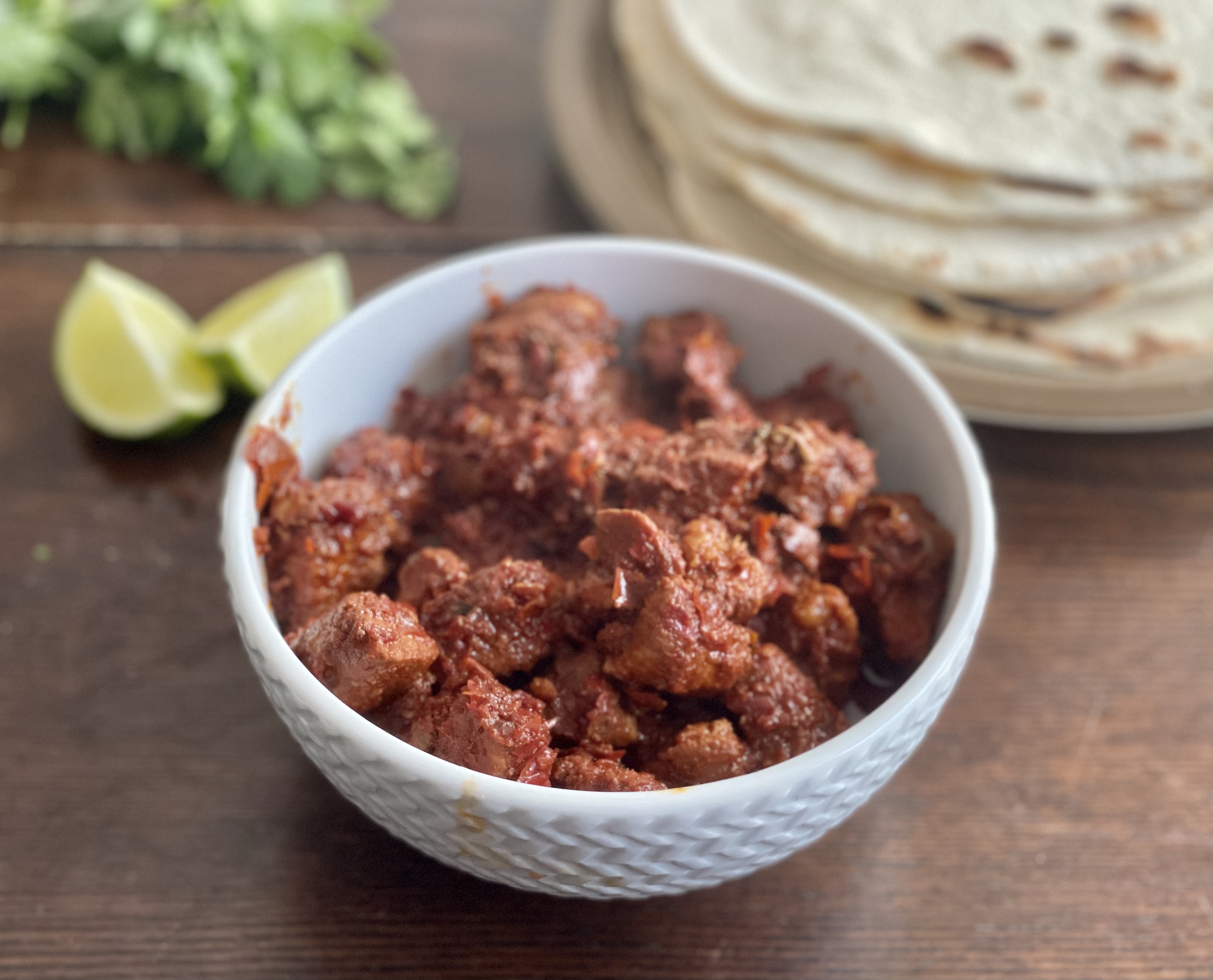
CARNE ADOBADA
Carne adobada (also spelled adovada) is New Mexico’s signature dish, dating back to Pueblo, Apache, and Navajo tribes and evolving over time with the influence of Spanish, Mexican, French, and Anglo settlers in the area. Made with their famous New Mexico chilis, this pork is fall-apart tender and packed full of flavor!
It was a bit of a challenge to find the best recipe for adobada. It seemed like everyone agreed it needed a ton of red chilis, vinegar, and Mexican oregano, but other ingredients and the way to prepare them varied so much in the recipes I found online. I tried to make sure to use the essential traditional elements, but also borrowed from recipes that sounded good to me. The end result might not be 100% authentic (again, let me know in the comments!) but it turned out delicious either way!
I started by taking my huge bag of New Mexico chilis found at the Mexican grocery store, tearing off their stems, shaking out the seeds, and tearing the chilis into pieces. Those I soaked in boiling water, then combined with other flavors like the Mexican oregano, vinegar, and garlic. Using my immersion blender for the very first time, I whipped it up into a thick chile paste, tossed the pork pieces in it, and then let it marinate overnight.
A few of the recipes I found didn’t require any kind of marinating time, but “carne adobada” literally means “marinated meat”! It just didn’t make sense not to marinate it! I also saw recipes that called for browning the pork beforehand, but I didn’t find that necessary. Cooking the pork involved two and a half hours of braising, and the pieces exposed to the air got nice and brown anyway.
The smell as the pork cooked was heavenly–the kind of spicy savory scent that makes your mouth water instantly. When it was done cooking, it was such a rich red color that I was afraid it would be way too spicy for me. (I like a nice kick to my food, but I’m not the kind of person who enjoys being in pain while I eat.) But the flavor turned out to be much more mild than expected, almost like a curry! It was just hot enough that it paired great with cilantro lime rice and tortillas, but not so hot that I needed milk to go with it. I think I got a bag of chilis that said “mild” on it, though, so go for the spicier chili option if that’s your thing!
In short, this recipe was easy to put together and well worth the marinating and slow-cooking time put into it. I would definitely make this again for a crowd, and I hope to try the real thing someday!
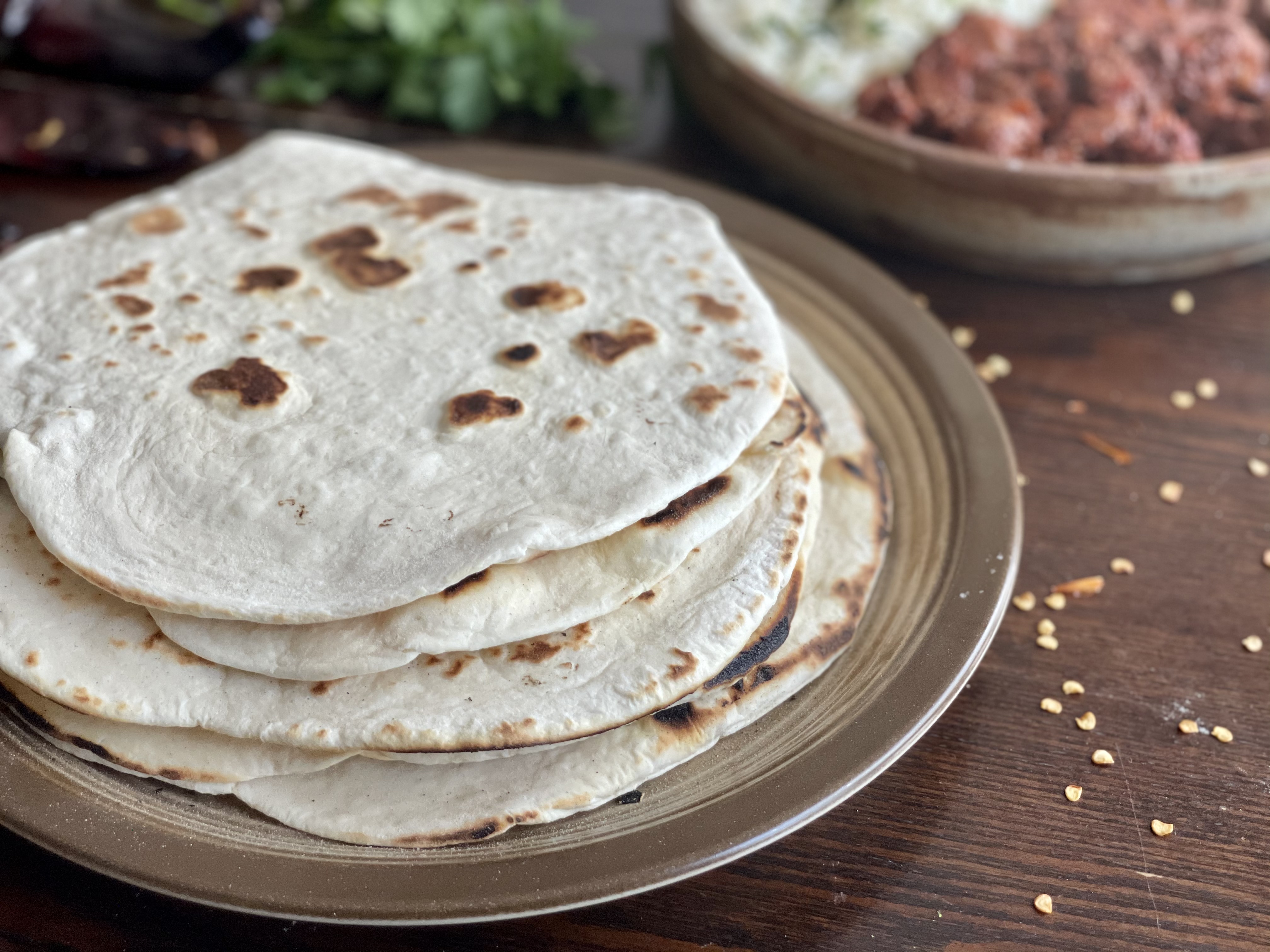
HOMEMADE TORTILLAS
I can still remember how disappointed my family was when I came home from my church mission in Paraguay and didn’t know how to make tortillas from scratch. My companions and I knew the basic concept and would throw together thick, bready tortillas when we craved tacos, but tortillas were not at all a staple in Paraguay like they are in Mexico!
And now . . . Well, this attempt was better than last time! I think I’m getting the hang of it the more I try. Even just in this batch, my first tortilla was very thick and very small, but I got better at rolling them out as I went, and the dough got more pliable the longer it sat out, so the last few tortillas turned out significantly better than the first few.
They still weren’t as thin as I would like–they folded up fine, but no way would I be able to shape burritos with them. Still, the recipe is good, and they tasted great. It’s really just all about the technique in shaping them, and that I haven’t quite gotten right. I would love the chance to learn from someone who really knows what they’re doing! Maybe next time I’ll try using a tortilla press and see how that works.
I highly encourage you to try making your own tortillas, though, if you can! They’re so much better than the store-bought kind! If you already know how to make homemade tortillas, I would love to hear any tips or tricks you may have!
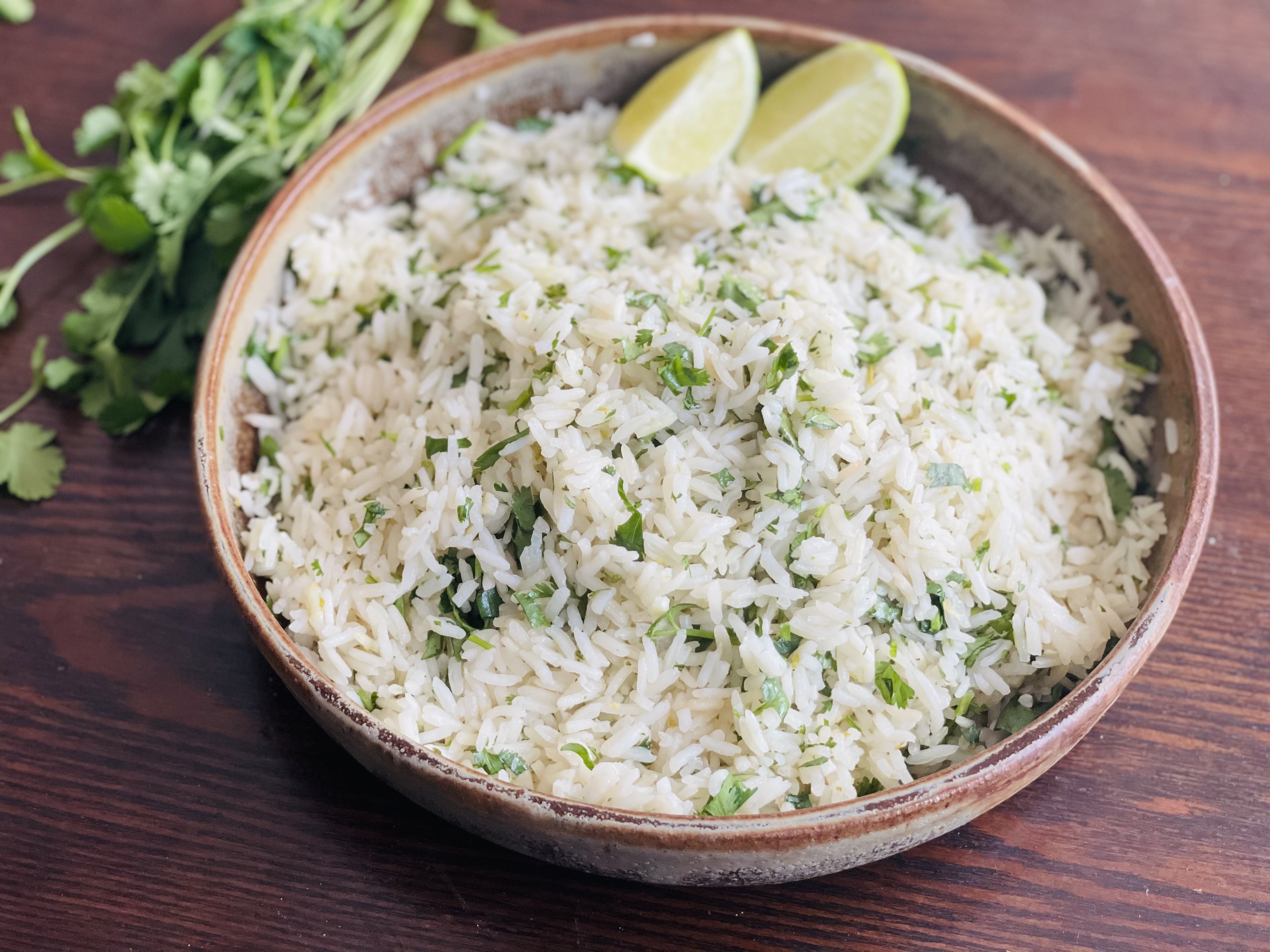
CILANTRO LIME RICE
If you’re one of those people who has the genetic hatred for cilantro, I’m so sorry.
This rice is divine. I’m a huge fan of jasmine rice lately, and the way it soaked up the flavors of the chicken broth, lime, and cilantro while still maintaining its own grainy flavor and light texture was just *chef’s kiss.* This paired so perfectly well with the carne adobada that I’ll probably always make them together in future.
I will say, though, that even though I like cilantro, I put about half as much into my recipe as other recipes I’ve seen called for. I found 1/2 cup to be the perfect amount, but it’s so easy to put more, or less, or probably none at all if you hate cilantro!
Not much else to say about this one–it’s exactly as advertised!
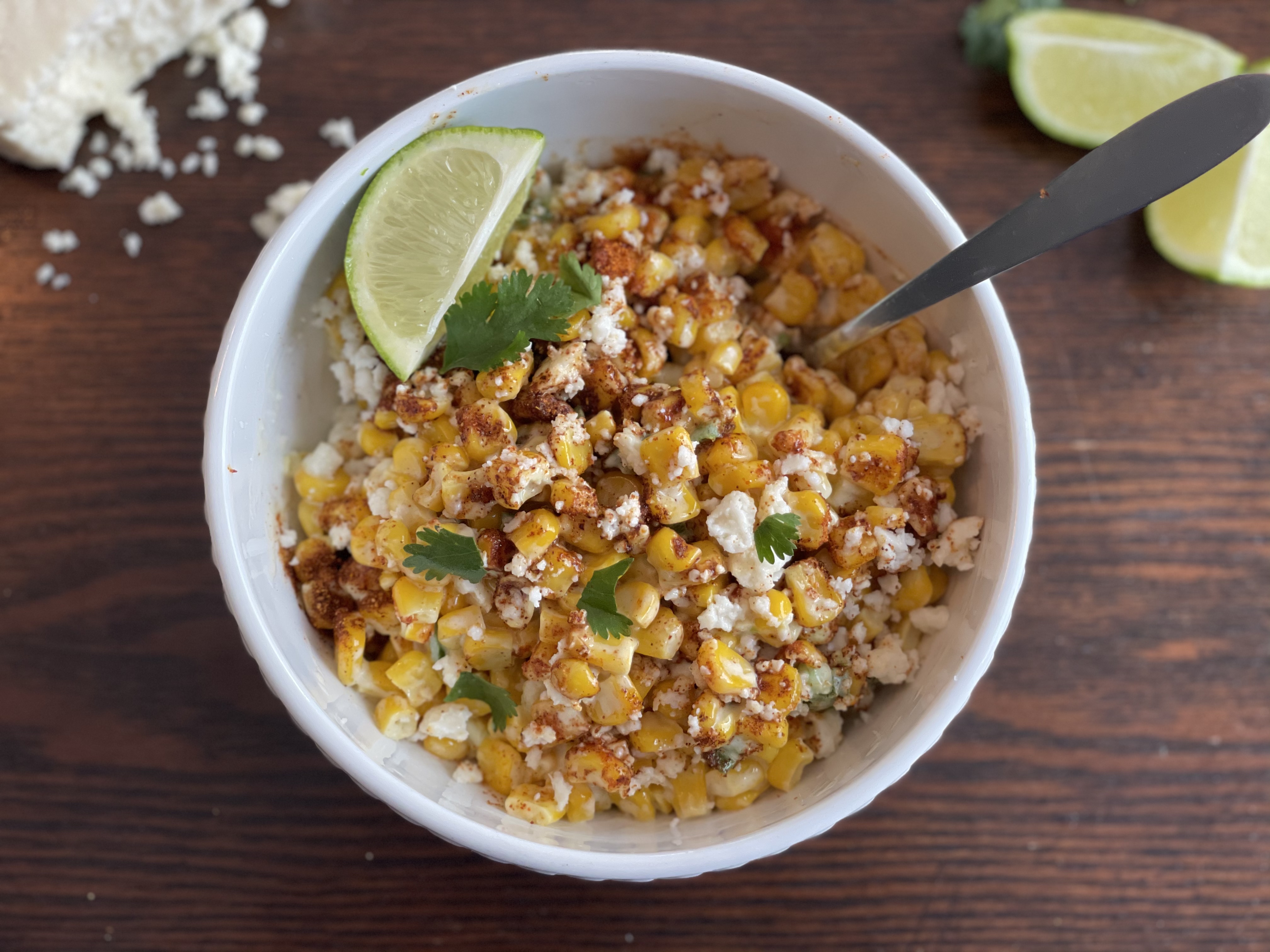
ESQUITES
You’ve probably heard of elote, Mexican street corn. Esquites is the easier-to-eat version, also called elotes en vaso or “street corn in a cup”! Elote is a very popular food in Mexico and New Mexico, but since I don’t have fresh corn on the cob yet, I decided to go with the cup version. It still has all the same signature flavors of elote, and frankly I’m not a huge fan of eating corn off the cob anyway!
As with everything else in this meal, this recipe was very simple. You just saute some corn kernels with a diced serrano or jalapeno pepper, then stir in some mayonnaise (or Greek yogurt if you’re mayonnaise-averse like some people in my family), and top with cumin, cayenne, crumbled queso fresco, and a squeeze of lime! Y ahi esta!
I’d never had these flavors with corn before, but I can see why it’s so well liked in Mexico! Every bite is a party of creamy, zesty flavors. It’s definitely a step above the basic butter and salt that we usually stick to!
A random fun fact before I move on: When I looked up the meaning of “esquites,” I learned that it’s not originally Spanish. It actually comes from the Nahuatl word “izquitl,” which means “toasted corn.” Nahuatl is a native Mexican language that has given us other commonly used words such as “chili,” “avocado,” “chipotle,” “chocolate,” and “tomato”! People have pointed out before that English is a confusing Frankenstein’s monster that absorbs and butchers words from all over the world, but I kind of love that my vocabulary secretly includes words from an ancient Mexican culture!
Anyway. Esquites. Super good!

LAVENDER LEMONADE
As much as I loved everything else in this meal, lemonade will forever and always be at the top for me. I was so happy when I was researching for this meal and discovered that lemonade is popular and significant in New Mexico. I’ll take any excuse to make myself a pitcher of my favorite drink!
Speaking of said popularity and significance, apparently Albuquerque, New Mexico, has an annual Lemonade Day, where children learn about entrepreneurship and smart spending by running lemonade stands with the help of mentors and their communities. So many people get into it and the children earn and budget their money so well that they end up donating millions of dollars to charity because of Lemonade Day each year!
My family used to live in Arizona and we had our own lemon trees that we still have access to even though we live in Utah now. My dad makes an annual pilgrimage to Arizona every January to restock his freezer with the juice from those lemon trees to last the whole year. We LOVE our lemon juice.
We usually just make basic lemonade with sugar, water, and lemon juice, but there are so many variation of lemonade to try. I chose this one because it showcases the vibrant lemons and lavender that thrive in harsh desert environments. It ended up being a nice spin on our go-to recipe!
Basically the only thing you do different to make this lemonade is mix dry lavender, sugar, and water together in a saucepan, first heating it to dissolve the sugar, then letting it cool and steep to let the lavender flavor sink in. Strain the lavender leaves out, add more water and lemon juice, and there you have it! Just add some ice or refrigerate before serving, and you have a beautifully tart, flowery beverage to sip on your front porch in the heat of the day.
I was worried that the lavender taste would overpower the lemon, but actually the opposite was true. Our lemon juice is just too flavorful for the lavender to be more than a faint aftertaste. I think next time I’ll let the lavender steep longer, or maybe add more initially, so that it will be more distinctive. If you try this recipe with store-bought lemon juice or more lavender or whatever, please let me know how it turns out! Or if you have any other suggestions for different lemonade flavors, I’m all ears!

BISCOCHITOS
Last but certainly not least, for an iconic New Mexican dessert, I made biscochitos!
Developed in Santa Fe, New Mexico, by Spanish colonists and the Pueblo people, biscochito cookies are light, fragrant shortbread cookies that would be perfect for a Christmas cookie exchange! New Mexico is so fond of these cookies that they named them New Mexico’s official state cookie in 1989–the first time any state adopted an official state cookie!
I think I did a pretty good job making these–they tasted amazing but my dough was more wet than I expected. I think because I used anise extract instead of crushed anise, and I zested my orange straight over the bowl instead of doing it over a paper towel to absorb some of the orange juice. I had to use a lot of flour to repeatedly dust my work surface and rolling pin to make it workable.
But I tried to stay as close to authentic as possible! I even used lard instead of butter, which I was trepidatious about at first. I was almost hoping that I wouldn’t be able to find any lard at the store and would be forced to use butter instead. 🙂 Butter would definitely give these a different flavor, but they taste great with lard, too! I think in my mind I expected lard to taste like bacon grease or something, but obviously it’s much more neutral than that, more like shortening.
With the combination of anise, orange zest, and cinnamon, these cookies were so flavorful without being overly sweet. I loved the shortbread texture. They’re a little dry and cloying on their own, but they’d be great with some hot chocolate or something. I’m definitely going to make these again at Christmas! The flavors are perfect for the winter holidays.
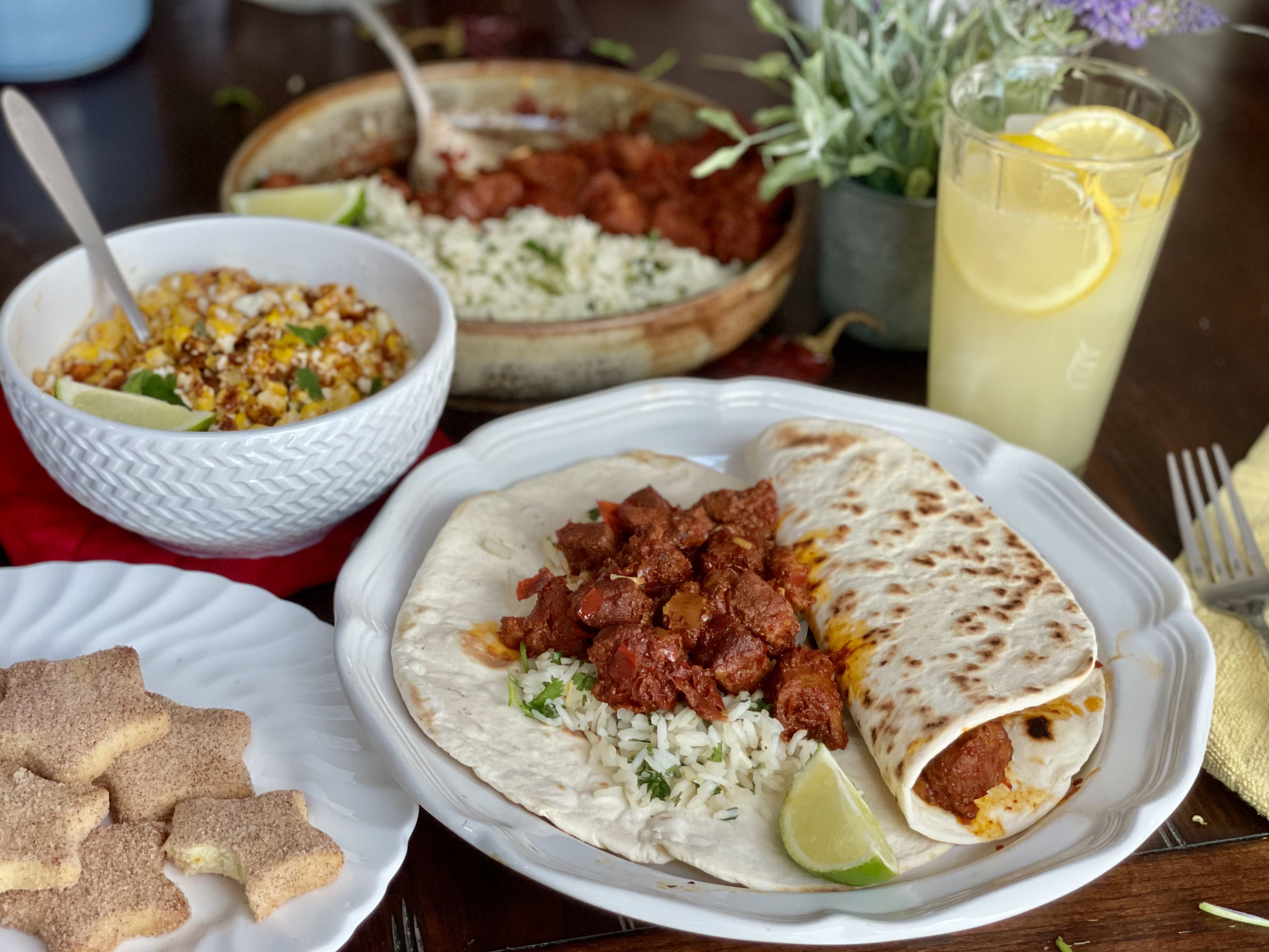
CONCLUSION
There you have it, New Mexico! Thank you so much for the inspiration to make some amazing new foods! I loved learning more about Mexican recipes and using ingredients I never have before. This is another meal full of recipes I want to keep close to hand and make again in the near future–it was all delicious! I hope my efforts did New Mexico proud!
So how’d I do? Let me know in the comments if you have any suggestions for improvement, and be sure to tune in next time for my take on a meal inspired by Texas! If that’s where you’re from, what do you think I should make to represent your state? Bonus points if you have reliable recipes or pro tips before I make the attempt! Thank you for reading!
